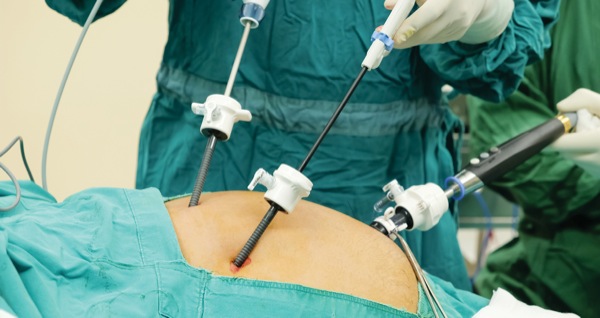About Treatment
Laparoscopic cholecystectomy or laparoscopic removal of the gallbladder is a method of surgical treatment in which a pathologically altered gallbladder is removed using laparoscopic techniques and endoscopic instruments.
Laparoscopic removal of the gallbladder combines radical interventiom with low trauma, allows operations using minimal incisions in the patient's skin. This allows you to almost completely preserve the integrity of the soft tissues of the abdominal wall, including the aponeurosis and muscles.
Removal of the gallbladder by laparoscopy practically eliminates the risk of postoperative ventral hernia formation. When performing laparoscopic removal of the gallbladder, in comparison with traditional cholecystectomy, the recovery time of patients is significantly reduced, which has a significant economic effect.
Laparoscopic gallbladder removal has distinct technical advantages over traditional cholecystectomy:
-possibility to perform simultaneous (combined) operations without an additional incision of the anterior abdominal wall,
-identification of concomitant pathology of the abdominal organs during laparoscopy,
-improvement of visualization of the surgical intervention area, especially with a deep location of the gallbladder in obese patients and hypersthenics.
Considering that gallstone disease is more often observed in women, and often at a young age (30–40 years), the cosmetic result of the intervention is of no small importance - small skin incisions (5–10 mm) heal with the formation of subtle scars.
How is Laparoscopic Gallbladder Removal Performed?
Laparoscopic cholecystectomy is performed under general anesthesia (endotracheal anesthesia). Surgeon inserts a special needle into the abdomen through which gas is injected into the abdominal cavity. This greatly improves the visualization of internal organs. Next, 4 incisions are made, up to 2-3 cm long, through which a video camera and instruments are inserted.
When removing the gallbladder, it is necessary to cross the cystic duct and artery. For this, metal clips are applied to them. The gallbladder is removed from the abdominal cavity through one of the incisions. A thin drainage is applied to the gallbladder bed and sutures are applied to the wounds.
-
Indications
Chronic calculous cholecystitis
Polyps and cholesterosis of the gallbladder
Acute cholecystitis
Chronic acalculous cholecystitis
Asymptomatic cholecystolithiasis
-
Inpatient Rehabilitation Period
7 days
-
Period of Incapacity For Work After the Procedure
One week
-
Contraindications
Severe pulmonary heart disease
Uncorrected bleeding disorders
Late pregnancy
Anatomical features of patient
-
Duration of Procedure
40-60 minutes
Due to the insignificance of the trauma to the anterior abdominal wall, the postoperative period after laparoscopic cholecystectomy is easier than after similar operation by dissecting the anterior abdominal wall. Patient can be activated within a few hours after the operation. Free mode is allowed on the second day. The general condition of patients in most cases allows them to be discharged on the third day after the operation. The period of incapacity for work in case of a smooth postoperative course is up to 1 week and depends on the degree of professional physical activity.
Delaying with a planned operation, you can only wait for an exacerbation or complications of the disease, and an emergency operation significantly increases operational and postoperative risks.
To date, laparoscopic cholecystectomy (endoscopic removal of the gallbladder together with stones) is the most effective way to treat gallstones.
Removal of the gallbladder removes the problem of cholecystitis, practically does not change the quality of life after the operation and allows you to insure you against many possible and sometimes dangerous complications of cholelithiasis.
-Painless
-The procedure is performed under general anesthesia
-With minimal trauma
-The procedure is performed laparoscopically through several 5-10 mm punctures of the anterior abdominal wall
-Safely
-Possibility to visually control the operation thanks to modern magnifying optics and monitors
With Laparoscopic Cholecystectomy, 4 incisions are made from 0.5 to 2 cm, in comparison to open surgery, when the incision length reaches 15-20 cm.
Postoperative pain after Laparoscopic Cholecystectomy is significantly less in comparison to open surgery.
The need for a patient to stay in the hospital after the operation is also significantly less (from 2 days) than after open surgery.
When making small incisions (up to 2 cm), formation of incisional hernias is extremely low.











